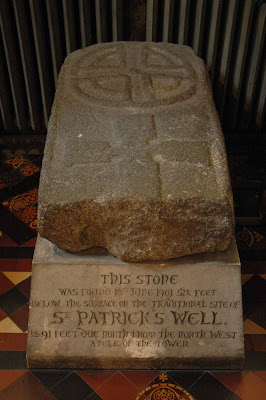Even though there has been a civilization of one kind or another for more than 2,000 years, most of it has been bulldozed or built over at some stage in Dublin's history. Therefore, there isn't as much still remaining as there could have been.
And, of course, every place has at least one story. Sometimes several. Frequently there are a multitude of variations. After all, the Irish have been known to sacrifice the truth for a good story.
Our first stop in Dublin (after eating, of course) was Trinity College. Founded in 1592 by Queen Elizabeth I, it has an amazing collection of buildings that show the major architectural influences from the 16th century through today. Trinity is one of the few places in Dublin that has always been maintained and never bulldozed.

However, the purpose of our visit was to see a piece of history far older than the college. We were there for the Books of Kells. Although there are many theories about exactly where and by whom the manuscript was created, it is known that it was created between the 7th - 9th centuries and was named for the Abbey of Kells in County Meath. It was held at the monastery until 1645, when it was sent to Dublin for safe-keeping. It was presented to Trinity College in 1661 and has remained there ever since.
The first time I saw the Book of Kells was back in 1990. I was wandering about Trinity College and saw a small, hand-made sign that said "Book of Kells" and had an arrow. I walked in the direction the arrow indicated and came into the Old College Library. I followed another sign that pointed up the stairs and there, at the top of the stairs was the entry way to the Old Long Room, filled with the rarest and most precious books. A security guard stood next to a display case with the Book of Kells in it and cheerfully chatted about it.
I was surprised to see that during the intervening years they have built a large gift shop and are now charging €8 per person to go through a newly built display and see the book itself. Frankly, in my student days I wouldn't have been able to afford it. Although I thought this same thing repeatedly on our trip as there is much that was once free, but now you are charged quite a lot to see.
Moving on...
Walking past the statue of Molly Malone (also given a set of nicknames: The Tart with the Cart, The Dish with the Fish, The Trollop with the Scallops) and to the top of Grafton Street will lead you to St. Stephen's Green, a 22-acre, Victorian-era park. Laid out in its current form in 1880 and given by Sir Arthur Guinness to the people of Dublin, it is the largest city park in Europe.
Surrounding St. Stephen's Green is the Georgian District, so called because of its streets filled with rows upon rows of houses from the Georgian Era. I especially loved the rows upon rows of chimneys that ran along the top. As I looked at them, flashbacks of Dick Van Dyke singing "Chim-Chim Cher-ee" came to mind.
Back north to the River Liffey, no trip to Dublin would be complete without a walk along Ha'Penny Bridge. It first opened in 1816 as a toll bridge. Any guesses as to how much it cost to cross it back then? Fortunately, Ha'Penny Bridge is one of those Dublin landmarks that remains free to see.
Another site we decided to go back to see was the Guinness Storehouse. An old storehouse at the center of St. James Brewery, where Guinness originates, it was opened as a museum and "brewery experience" in 2000. Having visited the Anheuser-Busch Brewery in St. Louis (an excellent brewery tour that is a great overview of the history and process) and the Bacardi Rum Distillery in Puerto Rico (not as good as Anheuser-Busch, but still an enjoyable experience), we had high hopes for this visit. And were sorely disappointed. It is not terribly interesting or informative. At no time do you see the actual workings of the brewery. And it is over the top self-congratulatory.
I spent most of our time at Guinness, which wasn't long to begin with, experimenting with interesting camera angles and shots. Such as this one of a wall of televisions showing old Guinness commercials above some mirrors...
The self-guided tour ended at the Gravity Bar where we had an extremely expensive pint of "complementary" Guinness. The pint was €14, the cost of admission to the museum.
We finished our walking tour of Dublin at St. Patrick's Cathedral. The present cathedral was built between 1191 - 1270, but a church of some kind is likely to have been on this site almost since the days of St. Patrick himself (380? - 461). Originally the parish was Catholic. However, after the Reformation in England (1536 - 1564), the cathedral became Anglican and remains part of the Church of Ireland.
Near the entrance of the cathedral is the grave and bust of Jonathan Swift, who was Dean of the Cathedral from 1713 - 1745. He is best known as the author of Gulliver's Travels and other satirical works such as A Modest Proposal and Battle of the Books.
Opposite the entrance and tucked behind the gift shop is a find from an archaelogical dig conducted in 1901. It is a wellstone and was found over an ancient well a short distance from the cathedral that was in use until the 16th century. It is believed to be the site where St. Patrick baptized Christian converts. Regardless of whether it is or not, it does date back to Celtic times.





No comments:
Post a Comment